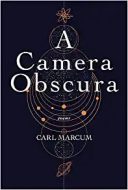 Carl Marcum
Carl Marcum
A Camera Obscura
Red Hen Press
Reviewer: Lee Rossi
Just as the James West Space Telescope (the J.W.S.T.) is about to supersede the Hubble Telescope (offering the difference between myopia and 20-20 vision, at least when it comes to the far-far-far reaches of the universe), Carl Marcum offers us A Camera Obscura, a book which aims its lens at the mysteries of astronomy but also those of life.
In “The Hubble Meditations,” a sequence based on Deep Space photographs taken by the Hubble in 2014, we learn that “Paradigms shift, space expands / more mythic than our capacity to comprehend. / Andromeda: named, numbered, catalogued.” (The section is called “Messier Object 31,” another name for the Andromeda nebula, the galaxy nearest our own Milky Way.) Ranging widely in their search for meaning, “The Hubble Meditations” scour not just Deep Space but also Deep Time, “the earthen-cold // caves of Lascaux and Chauvet where shamans ochered / animal visions against stone walls.” (“Horsehead Nebula”)
Marcum’s point is that however we deal with the incomprehensible, be it simple naming, precise description, myth, or science, the incomprehensible eludes our understanding.
A cosmic plaintiveness suffuses this volume. As a person who experienced his own romance with cosmology—what I like to call my blackhole period—I notice Marcum’s fascination with extreme states: exploding stars, plasmas moving near the speed of light, gravitational fields in which stars shrink to the size of golf balls. In “A Science Fiction,” for instance, a poem based on speculations by physicist Stephen Hawking, the poet describes being sucked into a black hole: “This is what I can expect: / gravity, density, volume dissipating.” What better metaphor for death?
Of course, Marcum’s interests are not limited to physics. He writes movingly about family, love, and parenthood. Mexican and Catholic on his mother’s side, he interrogates his mixed-race identity with ruthless precision. In an earlier poem, “Dreaming Pancho Villa” from his 2001 collection, Cue Lazarus, we hear the following complaint:
But this morning I awoke again
white and assimilated into these cobwebs
of my half-self. When did I forget
my mother? …
Carlos Gringo, Carlos Murphy.
Part mexicano,
part Kentucky hillbilly.
I’ve angloed my way
through this life.
Impossible not to hear self-disgust in these lines. In the current book, this self-loathing is transformed into something angrier. In “Further Notes from the Art Institute,” an ekphrastic poem based on a ritual figurine of a flayed human, common enough in pre-colonial Mexico, Marcum impersonates the flayer, speaking almost as a lover to the “dear one” who will insure bountiful harvests and whose handsome face will actually look better covering his killer’s high cheeks:
I will wear your skin,
dear one, among your own
people. They will always
mistake me for kind.
I can’t think of a more gruesome metaphor for “passing.” Notice also the pun; because he’s one of their kind, he will always be considered kind. Talk about “affinity fraud”! The macabre violence of “Further Notes” is picked up in the succeeding poem “Bad Wolf,” where sheep’s clothing cannot hide a thirst for blood, for vengeance: “A wolf is a wolf, & that is the door.” Of course, not all of Marcum’s poems about identity are so dire. “Woolgathering,” for instance, is an amusing anecdote about “cruisin’” while “gringoing” in Nogales, Mexico.
A Camera Obscura also includes some tender moments. “First Snow,” an elegy for his mother, packs a lot into a few short lines: the birth of his sister, his mother’s longing for her desert home, the poet’s longing for his mother:
Remember us,
Mother? You,
postpartum, sister
asleep in another room.
I had you
to myself again.
… how you yearned south
—missing the desert
the way I watch
out this window
missing you
with each
gathering star.
Or consider these lines from “Twenty-Three Weeks,” in which he notices a young sparrowhawk:
he buckled from the telephone
wire … rose again,
a matted mouse in his talons. The natural
order indifferent as the city.
At times Marcum reads like a late Victorian, still wrestling with the shock of Darwin, using recent discoveries in cosmology as metaphors for the marginalization of mankind in the story of the universe. This is probably most evident in the poem subtitled “The Drake Equation Ending in Fermi’s Paradox.” For those of you late to the twenty-first century (a group which includes myself), the Drake Equation is an attempt, most famously employed by the Cornell astronomer Carl Sagan, to estimate the number of other space-faring species in the Milky Way galaxy. The number could be very large (“Keeping Up with the Cardassians!” might be coming to TV screens in the near future) or vanishingly small; it all depends on the values you assign to the various coefficients; e.g., how many planets are capable of producing intelligent life, how many intelligent species develop complex civilizations, how long are those civilizations capable of generating messages that might travel the galaxy? Fermi’s paradox suggests that we may never meet anyone like ourselves, no Contact, no Arrival, just, as Marcum puts it: “This endless babble, this civilized technology, this cosmic static.”
Rivka Galchen (in a recent article in the New Yorker about the J.W.S.T.) writes: “Each time we look farther, our universe gets larger. Or, depending on your perspective, we get smaller.” With Marcum as our guide through Space and Time, we learn not only how small we are but also how vast is the imagination.

